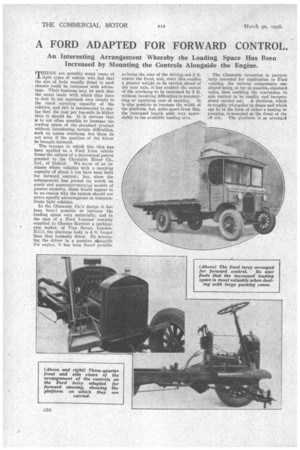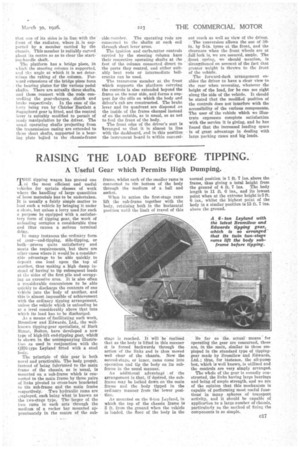A FORD ADAPTED FOR FORWARD CONTROL.
Page 14

Page 15

If you've noticed an error in this article please click here to report it so we can fix it.
An Interesting Arrangement Whereby the Loading Space Has Been Increased by Mounting the Controls Alongside the Engine.
rillIERE are possibly many users of 1light types of vehicle who feel that the size of body usually fitted to such chassis could be increased with advantage, Their business may be such that the usual loads with which they have to deal do not approach very closely to the rated carrying capacity of the vehicles, and this is tantamount to saying that the cost per ton-mile is higher than it should be. It is obvious that it is net often possible to increase the loading space of the standard product without introducing certain difficulties, such as undue overhang, but these do not arise if the position of the driver be brought forward.
The manner in which this idea has been applied to, a Ford 1-ton vehicle forms the subject of a provisional patent granted to the Chaseside Motor Co., Ltd., of Enfield. We know of no instance where vehicles with a carrying capacity of about 1 ton have been built for forward control ; but, since the arrangement has proved its worth on goods and passenger-carrying models of greater capacity, there would appear to be no reason why the system should not prove equally advantageous on comparatively light vehicles.
In the Chaseside Co.'s design it has been found possible to increase the loading space very materially, and in the case of a Ford 1-tonner recently supplied to Charles Bartlett a packingcase maker, of Vine Street, London, E.C.1, the platform body is 4 ft. longer than that normally fitted. By arranging the driver in a position alongside the engine, it has been found possible to bring the rear of the driving cab 2 ft. nearer the front, and, since this enables a greater weight to be carried ahead of the rear axle, it has enabled the extent of the overhang to be increased by 2 ft. without involving difficulties in manoeuv ring or upsetting ease of steering. It is also possiale to increase the width of the platform, but, quite apart from this, the increased length adds very appreciably to the available loading area.
The Chaseside invention is particularly intended for application to Ford vehicles, the various components employed being, so far as possible, standard units, thus enabling the conversion to side control to be readily and inexpensively carried out. A platform, which is roughly triangular in shape and which can be in the form of either a casting or pressing, is mounted at the front of the off side. The platform is so arranged
that one of its sides is in line, with the front of the radiator, where it is supported by a member carried by the chassis. This member is suitably curved about its centre so as to clear the starting-handle shaft The platform has a bridge piece, in bich the steering column is supported, and ths angle at which it is set determines the raking of the column. Forward extensions of the bridge piece form the bearing plates for the various pedal shafts. There are actually three shafts, and these connect with the rods controlling the gear-changes, clutch and brake respectively. In the ease of the lorry being run by Charles Bartlett a 8upaphord gear is fitted, and the control lever is suitably modified to permit of ready manipulation by the driver. The usual operating shafts projecting from the transmission casing are extended to three short shafts, supported in a bearing plate bolted to the chassis-frame side-member. The operating rods are connected to the shafts at each end through short lever arms.
The ignition and carburetter controls carried by the steering column have their respective operating shafts at the foot of the column connected direct to the parts they control, and either suitably bent rods or intermediate bellcranks can be used.
The transverse member at the front which supports the platform carrying the controls is also extended beyond the frame on the near side, and forms a support for the sills on which the body and driver's cab are constructed. The brake lever and its quadrant are disposed an the inside, of the frame channel instead of on the outside, as is usual, so as not to foul the front of the body.
The front edge of the driver's seat is turanged so that it is almost in line with the dashboard, and in this position. the instrument board is within conseni
ent reach as well as view of the driver.
The cenversion allows the use of 30in. by 5-in. tyres at the front, and the clearance when the front wheels are at full lock is, we are assured, ample. The front spring, we should mention, is strengthened on account of the fact that greater weight is thrown to the front of the vehicle.
The forward-dash arrangement enables the driver to have a clear view to the rear when reversing, whatever the height of the load, for he can see right along the side of the vehicle. It should be stated that the modified position of the controls does not interfere with the accessibility of the various components. The user of the vehicle which we illustrate expresses complete satisfaction with the service it is giving, and he has found that the increased loading space is of great advantage in dealing with large packing cases and big loads.


































